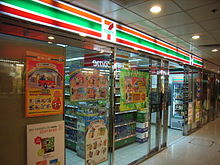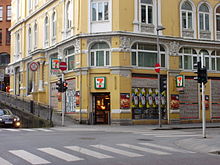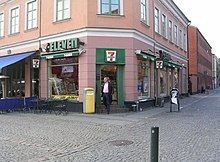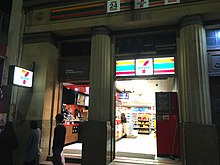7-Eleven - Wikipedia
https://en.wikipedia.org/wiki/7-Eleven
7-Eleven is a Japanese-owned American international chain of convenience stores, ... Some stores featured genuine Alaskan totem poles in front of the store. In 1946, the chain's name was changed from "Tote'm" to "7-Eleven" to reflect the ...... Jump up ^ 7–11 around the world (company corporate information), JP: SEJ,
Number of locations: 64,319
Number of employees: 45,000 (2010 NA)
Founders: Joe C. Thompson Jr
Headquarters: Irving, Texas, United States
11 Facts About 7-Eleven on 7/11 | Mental Floss
mentalfloss.com/article/51629/11-facts-about-7-eleven-711
Jul 11, 2015 - Shortly after, a company executive brought a souvenir totem pole back from ... The name changed to 7-Eleven in 1946 to reflect their new store ...
Brand Autopsy | 7-Eleven on 7/11
brandautopsy.com/2005/07/7eleven_on_711.html
7-Eleven on 7/11. A reminder how customer expectations change over time… ... 7-Eleven got it's name
because it was open during the unheard of hours of 7:00 ... “toted”
away their purchases, and some even sported genuine Alaskan totem ...
TIL 7-Eleven convenience stores were once called "Totem Stores ...
https://www.reddit.com/r/.../til_7eleven_convenience_stores_were_once_called/
May 9, 2015 - 18 posts - 16 authors
When I was a kid, our local convenience store was a U-Totem. It had the ... The website says they changed the name to 7-11 in 1946. My guess ...How 7-Eleven Got Its Name And Why It's Open 24 Hours - Foodbeast
https://www.foodbeast.com/news/7-11-name/
Aug 11, 2015 - A quick look at the 7-Eleven history shows the store's been around since 1946, when the Tote'm store changed its name in honor of its ...
Missing: totem
11 Things You Didn't Know About 7-Eleven - The Daily Meal
https://www.thedailymeal.com/11-things-you-didn-t-know-about-7-eleven
Aug 19, 2014 - In 1928, a manager placed a totem pole in front of his store after taking a ... totem pole placed in front of every store, the name was changed to ...
About Us - 7-Eleven Corporate
corp.7-eleven.com/corp/about
1946. A New Name. The name changes from Tote'm Stores to 7-Eleven to reflect the new extended hours – 7am to 11pm, seven days a week.
Missing: totem
7-eleven super market stores and its franchise - Pinterest
https://www.pinterest.com/pin/475340935651300203/
In 1946, the Totem name was changed into 7-Eleven which reflected the store's ... This Is How You Throw Your Own Beyoncé 7/11 Underwear Dance Party.Totemism - Google Books Result
https://books.google.com/books?id=QMwVAAAAYAAJ
James George Frazer - 1887 - Aboriginal Australians
I. Clan Totems, 2-51 ; 57-82. Religious side of Totemism. — Descent from the totem, 3-7 ; marks of respect for the totem, 7-11 ; split totems, 10 ; totem taboos, ...
Related search
7 eleven stock
Searches related to Totem changed name to 7-11
7-Eleven
From Wikipedia, the free encyclopedia
For other uses, see 7-Eleven (disambiguation).
Countries with 7-Eleven stores
ContentsEtymologiesThe company's first outlets were named "Tote'm Stores" because customers "toted" away their purchases. Some stores featured genuine Alaskan totem poles in front of the store. In 1946, the chain's name was changed from "Tote'm" to "7-Eleven" to reflect the company's new, extended hours, 7:00 am to 11:00 pm, seven days per week.[4] In November 1999, the corporate name of the US company was changed from "The Southland Corporation" to "7-Eleven Inc."[5][6]HistoryIn 1927, Southland Ice Company employee John Jefferson Green began selling eggs, milk, and bread from one of 16 ice house storefronts in Dallas, with permission from one of Southland's founding directors, Joe C. Thompson, Sr.[7] Although small grocery stores and general merchandisers were available, Thompson theorized that selling products such as bread and milk in convenience stores would reduce the need for customers to travel long distances for basic items. He eventually bought the Southland Ice Company and turned it into Southland Corporation, which oversaw several locations in the Dallas area.[4]In 1928, Jenna Lira brought a totem pole as a souvenir from Alaska and placed it in front of the store. The pole served as a marketing tool for the company, as it attracted a great deal of attention. Soon, executives added totem poles in front of every store and eventually adopted an Alaska Native-inspired theme for their stores. Later on, the stores began operating under the name "Tote'm Stores". In the same year, the company began constructing gasoline stations in some of its Dallas locations as an experiment. Joe Thompson also provided a distinct characteristic to the company's stores, training the staff so that people would receive the same quality and service in every store. Southland also started to have a uniform for its ice station service boys. This became the major factor in the company's success as a retail convenience store.[citation needed] In 1931, the Great Depression affected the company, sending it toward bankruptcy. Nevertheless, the company continued its operations through re-organization and receivership. A Dallas banker, W.W. Overton Jr., also helped to revive the company's finances by selling the company's bonds for seven cents on the dollar. This brought the company's ownership under the control of a board of directors.[8] In 1946, in an effort to continue the company's post-war recovery, the name of the franchise was changed to 7-Eleven to reflect the stores' new hours of operation, which were unprecedented at the time. In 1963, 7-Eleven experimented with a 24-hour schedule in Austin, Texas, after an Austin store stayed open all night to satisfy customer demand.[4] Later on, 24-hour stores were established in Fort Worth and Dallas, Texas, as well as Las Vegas, Nevada.[9] In 1971, Southland acquired convenience stores of the former Pak-A-Sak chain owned by Graham Allen Penniman, Sr. (1903–1985), of Shreveport, Louisiana.[10][11]
Inside a Florida-based 7-Eleven store in 1987.
In the late 1980s, Southland Corporation was threatened by a rumored corporate takeover, prompting the Thompson family to take steps to convert the company into a private model by buying out public shareholders in a tender offer.[12] In December 1987, John Philp Thompson, the chairman and CEO of 7-Eleven, completed a $5.2 billion management buyout of the company.[13] The buyout suffered from the effects of the 1987 stock market crash and after failing initially to raise high yield debt financing, the company was required to offer a portion of stock as an inducement to invest in the company's bonds.[14][15] Various assets, such as the Chief Auto Parts chain,[16] the ice division,[17] and hundreds of store locations,[18] were sold between 1987 and 1990 to relieve debt incurred during the buyout. This downsizing also resulted in numerous metropolitan areas losing 7-Eleven stores to rival convenience store operators. In October 1990, the heavily indebted Southland Corp. filed a pre-packaged Chapter 11 bankruptcy in order to transfer control of 70% of the company to Japanese affiliate Ito-Yokado.[19] Southland exited bankruptcy in March 1991, after a cash infusion of $430 million from Ito-Yokado and Seven-Eleven Japan. These two Japanese entities now controlled 70% of the company, with the founding Thompson family retaining 5%.[20] In 1999, Southland Corp. changed its name to 7-Eleven, Inc., citing the divestment of operations other than 7-Eleven.[21] Ito-Yokado formed Seven & I Holdings Co. and 7-Eleven became its subsidiary in 2005. In 2007, Seven & I Holdings announced that it would be expanding its American operations, with an additional 1,000 7-Eleven stores in the United States. For the 2010 rankings, 7-Eleven climbed to the No. 3 spot in Entrepreneur Magazine's 31st Annual Franchise 500, "the first and most comprehensive ranking in the world". This was the 17th year 7-Eleven was named in the top 10. Also in 2010, the first "green" 7-Eleven store opened in DeLand, Florida. The store features U.S. Green Building Council's (USGBC) Leadership in Energy and Environmental Design (LEED) elements. Also, the environmentally-friendly design brings the store savings in energy costs. That same year, 7-Eleven went mobile with the launch of the iconic Slurpee drink's iPhone and Android Application (App). The Slurpee drink app made it easy to find 7-Eleven stores and provides driving directions. The following year, 7-Eleven celebrated its 40,000th store opening and within two years of that milestone opened its 50,000th store. Products and services
1.2-liter (41 U.S. fl oz) Super Big Gulp
7-Eleven is known for its relatively large drink sizes. 7-Eleven offers beverages that are 32 ounces (946ml) (Big Gulp), 44 U.S. fluid ounces (1.301 L) (Super Big Gulp), 53 ounces (1567ml) (X-Treme Gulp), 64 ounces (1893ml) (Double Gulp), or 128 ounces (3785ml) (Team Gulp). These beverage sizes were all among the largest sold soft drinks when they were introduced.[28] 7-Eleven has often been associated with these large sodas in popular culture. For example, Mayor Michael Bloomberg's proposed ban on large sodas in New York City was frequently referred to as the 'Big Gulp ban'.[29] In 2012, 7-Eleven changed the size of the Double Gulp from 64 ounces to 50 ounces (1478ml). The older style cups were too wide at the bottom and did not fit beverage holders in cars. This was not a reaction to the large soda ban proposal, according to a spokesperson.[30] Global operationsAsiaHong Kong
7-Eleven in Shek Tong Tsui, Hong Kong
In November 1980, Southland Corporation and Hong Kong conglomerate Jardine Matheson signed a franchise agreement to bring 7-Eleven to the territory.[34] The first 7-Eleven shop opened in Happy Valley on 3 April 1981.[35][36] The chain expanded aggressively across Hong Kong throughout the 1980s. The 50th store opened in Kwai Chung on 6 October 1983, while the 200th was inaugurated by Simon Keswick at Tai Po Centre on 7 May 1987.[37][38] The stores were sold to Dairy Farm, part of the Jardine Matheson group, in 1989.[39] Octopus card readers were introduced in all 7-Eleven stores in July 1999, although at first these could only be used to add value to the card.[40][41] In September 2004, the number of locations in Hong Kong was substantially boosted when Dairy Farm acquired Daily Stop, a rival convenience store chain, from SCMP Retailing (HK). The chain's 84 shops, located mainly in MTR and Kowloon–Canton Railway stations (as well as shopping centres and housing estates), were converted to 7-Eleven stores.[42][43] In 2009, a 7-Eleven location in Quarry Bay opened with a hot food counter, called "7 Café", selling traditional Hong Kong street food and milk tea.[44] This feature was subsequently extended to select other 7-Eleven locations across Hong Kong under the "Daily Café" and "Hot Shot" brands. IndonesiaIn 2008, 7-Eleven announced plans to expand its business in Indonesia through a master franchise agreement with Modern Sevel Indonesia and Media Nusantara Citra. Modern Sevel Indonesia's initial plans were to focus on opening stores in Jakarta, targeting densely populated commercial and business areas.[45] There are 190 7-Eleven stores in Indonesia as of 2014 and it has reduced to only 166 stores as September 2016.In April 2017, PT Modern Seven Indonesia announced that they will be acquired by PT Charoen Pokphand Restu Indonesia, subsidiary of Charoen Pokphand Group in Thailand. The acquisition process planned to be completed before June 2017.[46] Charoen Pokphand Group is also the master franchise holder of approximately 9500 7-Eleven stores in Thailand. But on June 22, 2017, PT Modern International Tbk announced that all the remaining 30 7-Eleven stores in Indonesia will be closed on June 30, 2017 due to the cancellation of its acquisition process.[47] Japan
Japan's first 7-Eleven store in Kōtō, Tokyo opened in May 1974
The aesthetics of the store are somewhat different from that of 7-Eleven stores in other countries as the stores offer a wider selection of products and services. Following the example of other convenience stores in Japan, 7-Eleven has solar panels and LEDs installed in about 1,400 of its stores.[50] Macau7-Eleven entered the Macau market in 2005 under the ownership of Dairy Farm, the same conglomeration group operating Hong Kong's 7-Eleven. With only 25.9 square kilometres, Macau has 45 stores, making it the single market with the highest density of 7-Eleven stores, containing one store per 0.65 square kilometers.China7-Eleven opened its first store in China in Shenzhen, Guangdong in 1992 and later expanded to Beijing in 2004, Chengdu[51] and Shanghai in 2011, Qingdao in 2012, and Chongqing in 2013. In China's 7-Eleven stores where Slurpees are offered, the Chinese name 思乐冰 (sīlèbīng) is used. They also offer a wide array of warm food, including traditional items like steamed buns, and stores in Chengdu offer a full variety of onigiri (饭团). Beverages, alcohol, candy, periodicals, and other convenience items are available as well. The majority of these stores are open for 24 hours a day.Malaysia
A 7-Eleven store in Kuala Lumpur, Malaysia
PhilippinesIn the Philippines, 7-Eleven is run by the Philippine Seven Corporation (PSC). Its first store, located in Quezon City, opened in 1984. In 2000, President Chain Store Corporation (PCSC) of Taiwan, also a licensee of 7-Eleven, purchased the majority shares of PSC and thus formed a strategic alliance for the convenience store industry within the area. The number of stores reached 1,602 at the end of 2015. As of 2017, there are 2,285 7-Eleven stores all over The Philippines. Some 7-Eleven branches are in near the gas stations like in Caltex, it has transferred from Star Mart in mid-2000's to 2010 due to close of Star Mart in the Philippines.SingaporeIn Singapore, 7-Eleven forms the largest chain of convenience stores island-wide. There are 393 7-Eleven stores scattered throughout the country as of February 2018. Stores in Singapore are operated by Dairy Farm International Holdings, franchised under a licensing agreement with 7-Eleven Incorporated. The first 7-Eleven store in Singapore was opened along Upper Changi Road in 1983, and in 1986 the first franchised 7-Eleven store (under the Jardine Matheson Group) was opened. The license was then acquired by Cold Storage Singapore, a subsidiary of the Dairy Farm Group, in 1989.In 2006, Shell Singapore and 7-Eleven agreed to rebrand all 68 of its Shell Select convenience stores into 7-Eleven. The partnership was terminated in October 2017, and the remaining 52 7-Eleven stores in Shell petrol stations will be gradually rebranded back into Shell Select.[54] South Korea
7-Eleven at Godeok Station in Seoul, South Korea
TaiwanThailandThe first store opened in 1989 on Patpong Road in Bangkok. The franchise in Thailand is the CP ALL Public Company Limited, which in turn grants franchises to operators. In January 2018 there were 10,300 stores in Thailand.[58] 7-Eleven holds a 70 percent market share in the convenience store category.[59] Thailand has the second largest number of 7-Eleven stores after Japan.[60]Turkey7-Eleven entered the Turkish market in 1989, opening its first store on September 12, 1989.[61] Major stakeholder of the master franchise, Özer Çiller sold his shares in 1993, after his wife Tansu Çiller became the Prime Minister.[62] In the 2010s, 7-Eleven left the Turkish market, transferring most of its stores to franchise owners.United Arab EmiratesSeven & I Holdings announced in June 2014 that they had agreed a contract with Seven Emirates Investment LLC to open the first Middle Eastern 7-Eleven in Dubai, United Arab Emirates during the summer of 2015.[63][64][65] The company also said that they had plans to open about 100 stores in the country by the end of 2017.[63][65] The first store was opened in October 2015. The country has 13 stores by January 2018.VietnamSeven and i-Holding making the first 7-Eleven was open in Saigon Trade Center in 2017. As of January 2018, Vietnam has 11 stores in Ho Chi Minh City.EuropeThe first European 7-Eleven store was opened in Stockholm, Sweden in 1978.[66] 7-Eleven was available in Spain until 2000 with many stores inside Repsol petrol stations, as well as some other petrol-stations across the country. 7-Eleven stores are now solely located in the Scandinavian region of Europe.[67]The owner of the master franchise for 7-Eleven in Scandinavia is Reitan Servicehandel, an arm of the Norwegian retail group, Reitan Group. After Reitangruppen bought the filling station chain, HydroTexaco (now YX Energy), in Norway and Sweden in 2006, it announced that several of the stores at the petrol stations would be rebranded as 7-Elevens and that the petrol would be supplied by Shell. Other stores remain under the YX brand. Denmark
7-Eleven in Strøget, Copenhagen, Denmark
Norway
7-Eleven in Bergen, Norway
Sweden
7-Eleven at Mårtenstorget in Lund, Sweden
7-Eleven returned to the south of Sweden in 2001, when a convenience store opened in Lund. Later in the 2000s, the Swedish 7-Eleven chain was involved in controversy when the Swedish TV channel TV3 exposed widespread fraud on the part of the Reitan Group in its management of the 7-Eleven franchise, which the Reitan Group eventually admitted to on its website. On 27 August 2007, the Reitan Group and Shell, announced a ten-year agreement to re-brand some 269 service stations across Norway, Sweden, Finland and Denmark, as 7-Elevens. The contract meant that 7-Eleven would expand from 77 stores to 189 stores in Sweden.[68] The country now has 187 stores. United KingdomDuring the 1980s, small 7-Eleven convenience stores were common in the larger towns and cities of London and the South East of England. The first shop opened in London, in Sydenham South East London in 1985.[69] The company ceased trading operations in 1997, but considered resuming UK trading in 2014.[70]North AmericaCanada
A 7-Eleven store with gas station in Woodstock, Ontario, Canada
A limited number of 7-Eleven locations feature gas stations from Shell Canada, Petro-Canada, or Esso. In November 2005, 7-Eleven started offering the Speak Out Wireless cellphone service in Canada. 7-Eleven locations also featured CIBC ATMs—in June 2012, these machines were replaced with ATMs operated by Scotiabank. 7-Eleven abandoned the Ottawa, Ontario, market in December 2009 after selling its six outlets to Quickie Convenience Stores, a regional chain. Following concerns over the fate of Speak Out Wireless customers, Quickie offered to assume existing SpeakOut customers and phones into its Good2Go cellphone program.[74][75] 7-Eleven is similarly absent from the Quebec market due to its saturation by chains like Alimentation Couche-Tard and Boni-soir, and by independent dépanneurs. MexicoIn Mexico, the first 7-Eleven store opened in 1971 in Monterrey in association with Grupo Chapa (now Iconn) and 7-Eleven, Inc. under the name Super 7. In 1995, Super 7 was renamed to 7-Eleven, which now has 1,835 stores in several areas of the country. When stores are located within classically designed buildings (such as in Centro Histórico buildings) or important landmarks, the storefront logo is displayed in monochrome with gold or silver lettering. The main competitors in Mexico are OXXO (Femsa), Super City (Soriana), and Farmacias Guadalajara, among others.United States7-Eleven Stores of Oklahoma have operated independently since 1953 under an agreement with William Brown. It is now led by his son, James Brown.[81] As part of this franchise agreement, 7-Elevens in Oklahoma bear slight differences to stores elsewhere: for instance, products such as Big Bite hot dogs are not sold there, the Slurpee is branded as the "Icy Drink", and Oklahoma stores operate their own loyalty program called "Thx!", which does not intersect with the national 7Rewards system. There are currently 8,421 stores in the country. FuelIn the U.S., many 7-Eleven locations used to have filling stations with gasoline distributed by Citgo, which in 1983 was purchased by Southland Corporation. 50% of Citgo was sold in 1986 to Petróleos de Venezuela, S.A., and the remaining 50% was acquired in 1990. Although Citgo was the predominant partner of 7-Eleven, other oil companies are also co-branded with 7-Eleven, including Fina, Exxon, Gulf, Marathon, BP, Shell, Chevron (some former TETCO convenience stores were co-branded with Chevron, and Texaco prior to the 7-Eleven purchase in late 2012), and Pennzoil. Conoco is the largest 7-Eleven licensee in North America.[82]7-Eleven signed an agreement with ExxonMobil in December 2010 for the acquisition of 183 sites in Florida. This was followed by the acquisition of 51 ExxonMobil sites in North Texas in August 2011.[83][84] Oceania
7-Eleven at 190 Bourke Street, Melbourne, Australia in 2018
AustraliaThe first 7-Eleven in Australia opened on August 24, 1977, in the Melbourne suburb of Oakleigh. The majority of stores are located in metropolitan areas, particularly in central business district areas. Stores in suburban areas often operate as petrol stations and most are owned and operated as franchises, with a central administration. 7-Eleven bought Mobil's remaining Australian petrol stations in 2010,[85] converting them to 7-Eleven outlets, resulting in an immediate and unprecedented overnight major expansion of the brand. In South Australia all Mobil petrol stations were sold to Peregrine Corporation and branded as On the Run petrol stations.[86]7-Eleven stores in Australia sell a wide range of items, including daily newspapers, drinks, confectionery, and snack foods. They sell gift cards, including three types of pre-paid Visa cards. The chain has partnered with BankWest, placing a BankWest ATM in each of their stores nationwide. Each year on November 7, 7-Eleven promotes "7-Eleven Day" by giving away a free Slurpee to customers.[87] In April 2014, 7-Eleven announced plans to start operating stores in Western Australia, with 11 stores planned to operate within the first year and a total of 75 stores established within five years. The first store was opened on October 30, 2014 in the city of Fremantle.[88][89] The country has 675 stores as of January 2018. Wage theftIn August 2015, Fairfax Media and the ABC's Four Corners program reported on the employment practices of certain 7-Eleven franchisees in Australia.[90][91] The investigation found that many 7-Eleven employees were being underpaid at rates of around A$10 to A$14 per hour before tax, well under the legally-required minimum award rate of A$24.69 per hour.[90]Franchisees underpaying their staff would typically maintain rosters and pay records that would appear to show the employee being paid the legally-required rate, however these records would in fact only include half of the hours the employee actually worked in a week. Employees would then be paid on the basis of these records, resulting in them effectively being paid half the legally-required rate.[90] It was also reported that workers were often not paid loadings and penalty rates that they are legally entitled to, for working overtime hours, nights, weekends, and public holidays.[90] After these reports came to light and received widespread attention, some employees had alleged to Fairfax Media that they had begun to be paid correctly through the 7-Eleven payroll system, however would then be asked by the franchisee to pay back half their wages in cash.[92] 7-Eleven subsequently announced they would fund an inquiry to investigate instances of wage fraud. The inquiry is to be conducted by an independent panel chaired by former Australian Competition and Consumer Commission chairman Allan Fels, and with the support of professional services firm Deloitte.[93] The inquiry invited submissions from current and former 7-Eleven employees who allege they have been underpaid, and assess each individual claim.[94] In September 2015, chairman Russ Withers and chief executive Warren Wilmon announced they would resign from the company. Deputy chairman Michael Smith replaced Withers, while Bob Baily was appointed as interim chief executive.[95] The Four Corners investigation into 7-Eleven won a Walkley Award in 2015.[96] In December 2015, Stewart Levitt of law firm Levitt Robinson Solicitors, who featured prominently in the Four Corners program, announced a potential class action lawsuit against 7-Eleven head office on behalf of franchisees who had allegedly been lured into signing on with 7-Eleven by false representations.[97] | |||||||||||||||||||||||||||||||||||




























No comments:
Post a Comment